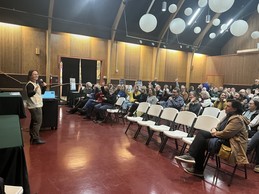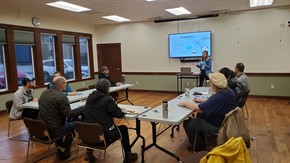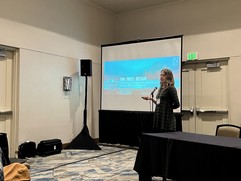|
From left to right: OSU master's student Jenny Waldo, Marine Reserves Human Dimensions Project Leader Tommy Swearingen, and OSU professor Dr. Megan Jones viewing the Otter Rock Marine Reserve. Photo by Mark Freeman.
The Marine Reserves Program is teaming up with two Oregon State University (OSU) researchers to study whether visiting Oregon beaches and other coastal access points can trigger personal changes that reduce global warming’s impacts. The study will focus on education and outreach about ocean acidification.
Ocean acidification is the byproduct of increased carbon dioxide dissolved in sea water over the past two centuries. It triggers chemical reactions that make seawater more acidic, impacting the entire ocean food web from fish to shellfish.
“Climate change is happening in everybody’s backyard and it’s happening globally,” says Dr. Megan Jones, the OSU conservation social scientist overseeing the study by master’s student Jennifer Waldo. “You don’t see OA (ocean acidification) with your naked eye, but it’s affecting local marine life and industries. Maybe this will make something abstract feel more relevant to people.” By adding this relevancy, researchers hope to gauge whether this spurs interviewees to make lifestyle changes that reduce their carbon footprint.
Four interviewers hope to garner about 2,000 interviews with ocean visitors at 23 sites, many at or near Oregon’s five marine reserves. The interviews will occur over a 10-week period beginning in June. The visitor interviews will be complemented by an online survey of about 1,400 Oregonians designed to investigate effective messages about ocean acidification. Marine Reserves’ Thomas “Tommy” Swearingen, Project Leader for the program’s human dimensions efforts, is helping with the study.
Rocky habitat species found in Oregon, including sea palm (Postelsia palmaeformis) and gooseneck barnacles (Pollicipes pollicipes).
We recently received several questions about updates to Oregon’s Territorial Sea Plan, and some new management areas proposed by the Oregon Department of Land Conservation and Development (DLCD). So, we wanted to share some information on the proposals to that plan’s Rocky Habitat Management Strategy.
Under the Territorial Sea Plan, DLCD has proposed new classifications for six portions of rocky shorelines along the Oregon Coast. The recommendations are to establish Marine Conservation Areas at Ecola Point, Cape Lookout, Fogarty Creek, Cape Foulweather, and Blacklock Point and a Marine Garden at Chapman Point.
These proposed sites are independent of Oregon’s Marine Reserves Program.
The Territorial Sea Plan is managed by DLCD and the Oregon Coastal Management Program. The proposals must be approved by the Oregon Land Conservation and Development Commission (LCDC) for them to become official. LCDC has scheduled a hearing on these proposals for April 20, 2023: register to watch. To learn more about the TSP updates, click here. LCDC previously added Coquille Point to its list of seven Marine Gardens and Cape Blanco to its contingent of six Marine Research Areas.
There are no proposals for adding any new marine reserves under the Marine Reserve Program, which is managed by the Oregon Department of Fish and Wildlife.
Our ecological team is gearing up for field season!
Assistant Ecological Project Leader Ryan Fields splices rope for moorings in preparation for the 2023 field season.
The Ecological Research Team has been busy building moorings for two ongoing projects this spring.
Our SMURFs (Standardized Monitoring Units for the Recruitment of Fishes) project, a collaborative effort with OSU that has been ongoing since 2011, focuses on determining what fish species are present when juveniles are recruiting into the nearshore environment. Specifically, the project aims to 1) quantify abundance and 2) identify community composition of settling temperate reef fishes. Moorings are placed in approximately 45 ft. of water with a bundle of plastic netting attached that will attract small juvenile fishes including rockfish, cabezon, and kelp greenling.
By taking samples every other week, we can better understand the timing of juvenile fish settling into the nearshore environment. We also attach oceanographic sensors to these moorings, including temperature, salinity, and oxygen loggers. We deploy SMURFs at the Otter Rock and Redfish Rocks Marine Reserves with help from the Oregon Coast Aquarium, OSU Small Boat Program, and commercial fishermen.
Deploying oceanographic moorings for the previous field season in 2022.
In addition to the oceanographic data collected from the SMURF moorings, we also deploy oceanographic moorings in the Cascade Head Marine Reserve, Cape Falcon Marine Reserve, and Cape Meares Comparison Area. Oceanographic moorings are deployed once in the spring and collected in September to provide valuable context to our biological data and help us understand long-term changes we see over time. Data from the Cape Falcon and Cape Meares oceanographic moorings represent the only nearshore oxygen data being collected on the north Oregon coast in state waters.
As our ecological team prepares for field season, we also are looking for volunteers to help with our hook-and-line surveys this year.
Assistant Ecological Project Leader Ryan Fields (left center) and hook-and-line volunteers at Cascade Head Marine Reserve in Fall 2022.
Do you have experience fishing in the ocean and would like to contribute to our Marine Reserves fish dataset? Sign up to be a hook-and-line volunteer angler for the 2023 season! We will be conducting hook-and-line surveys out of Garibaldi at the Cape Falcon Marine Reserve and out of Port Orford at the Redfish Rocks Marine Reserve in 2023.
Contact Ryan Fields: ryan.t.fields@odfw.oregon.gov
Outreach events are in full swing as our communications team has grown. Kendall Smith has stepped into the Communications and Engagement Project Leader position and will continue to expand communications, tools, outreach events and engage with community members through the end of June. Public Affairs Specialist Mark Freeman has been working to incorporate traditional media to expand reach and boost communication efforts. Marine Reserves staff have been giving presentations to coastal communities with takeaways from the 10-year synthesis report. Learn more about outreach events in March below!

Lincoln City:
Audubon Society of Lincoln City presents “A Deeper Dive into Oregon’s Marine Reserves” on Wednesday, March 15th where Program Leader Lindsay Aylesworth presented some of the successes and challenges of the first decade of the Marine Reserves Program.
|
|
Port Orford:
Marine Reserves Program staff hosted a “Deeper Dive into Oregon’s Marine Reserves” community outreach event in collaboration with the Redfish Rocks Community Team in Port Orford on March 20th.
|
|
 |
 |
|
Eugene:
Marine Reserves staff attended the American Fisheries Society 2023 Conference in Eugene and presented on program findings, updates, and future research.
|

Remote:
Lastly, our program participated in a webinar hosted by Environment America, entitled “Celebrating Oregon’s Coastal Ecosystems”. The webinar covered background information about the Marine Reserves Program and featured research findings from both the ecological and human dimensions teams. If you missed the webinar, check out the recording here.
|
Explore More Marine Reserves News
|